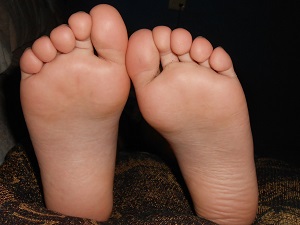
How Diabetics Can Protect Their Feet
It is important for diabetics to be aware of their feet, as they can develop complications which can affect the feet. Even if your diabetes is under control, it is still important to look out for signs of complications. The more common complications are reduced blood flow (Peripheral Arterial Disease (PAD) and Peripheral Vascular Disease (PVD)) and damage to the nerves (neuropathy).
Diabetic Complications Related to the Feet
When the blood is not flowing properly into the feet, it can affect healing time. Injuries take a longer time to heal, which can lead to a wound called an ulcer. This ulcer is an injury to the skin that does not heal properly. These need to be properly taken care of to prevent infection and further injury. In addition to skin wounds, other pain in the feet can take a longer time to heal.
The other complication affecting the feet, damage to the nerves (neuropathy), can create pain due to the nerve damage in diabetics. It can also reduce sensation in the feet, eliminating the necessary pain response you feel. The pain response is important because it warns you to avoid the area and to address the pain. For example, if there is a small rock or sharp object inside the shoe, the pain response will tell you to remove the object. Without the pain response, the object may injure the foot without any awareness.
Preventing Injuries in Diabetic Feet
The best way to deal with an injury or ulcer from developing, is to prevent it from occurring in the first place! An easy way to prevent a foreign object from injuring the skin is to develop a habit of checking the insides of the shoes. Before putting on shoes, look inside the shoe and underneath the insole for foreign objects.
Another good practice to adopt, is to check the bottom of the foot regularly for injury. If you are not able to do this yourself, there are ways to get them checked. Find someone else to check the bottom of the foot. This could be someone living in the same house, or someone who visits on a regular basis. A mirror can also be used to check the bottom of the foot. Place a mirror on the ground and hover each foot over the mirror. A phone on a selfie stick can be used as well. Using the selfie mode on the camera, extend the stick and hover the foot over the phone. If eyesight is an issue, take a few pictures to examine a little closer.
How to Recognize Pressure Spots in Diabetics
When examining the foot, it is important to check for pressure spots as well as for injury. There are a few visible signs of pressure spots to look out for. Calluses, corns and redness are easier to recognize as pressure spots.
A callus is an area of thickened skin, which develops from excessive pressure or friction. Calluses are commonly seen at the big toe and ball of the foot, but can develop anywhere on the foot.
Corns develop when there is a pinching or twisting friction. A corn is a round dot with a hard piece in the middle. This can be confused with a plantar wart, which is not related to pressure or friction. A wart may have a dark spot in the middle. To determine if you have a plantar wart or corn, speak to your health care professional.
Redness on the foot is the first indication of pressure, friction or even an area that needs to be dealt with. Even though redness may not be an immediate concern, this can easily develop into a concerning spot.
These pressure spots may be originating from improper shoe fit or the way the foot is interacting with the ground/moving though the gait cycle.
Pedorthic Treatments for Diabetics
For diabetics, pedorthic treatments such as proper footwear and support help to prevent pressure spots and pain from worsening in the feet.
Without the appropriate footwear and fit, pressure points can easily develop from pressure or shearing. Make sure the shoe has the appropriate support by testing the stability. The shoe should not bend easily through the middle of the shoe, or at the heel/back of the shoe. Also, make sure the shoe is fitting properly for both feet. Be especially aware with wide feet and bony prominences. In these cases, look for a wide and deep fitting shoe. Look out for shoes that point too much at the toes, as this can compress the toes and cause pressure. A good way to determine if the shoes fit properly, is to take out the original insert, stand on it and observe your feet. All the toes and the widest points of the foot should not be overhanging. If there is an overhang, the shoe is likely rubbing or compressing these areas.
Proper support helps to prevent pressure and rubbing due to they way you are walking. It helps to offload and redistribute pressure where there shouldn’t be. In addition to pressure, the support also reduces strain to muscles and other structures in the foot and lower legs. The proper support is typically addressed with a custom-made foot orthotic to offload and address specific areas that need to be dealt with.
Once the pressure has been offloaded, it is important to remove any corns and calluses. These corns and calluses form to protect the foot, but once the pressure has been removed through the proper footwear and support, they can actually cause extra unwanted pressure.
If you have additional questions, feel free to contact us!

You must be logged in to post a comment.